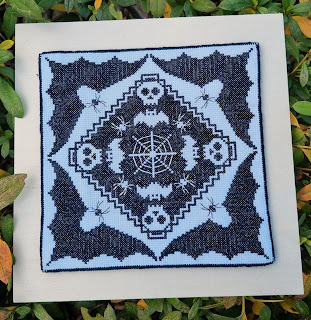Firstly, why choose the Bat Conservation Trust to raise money for? BCT does amazing work in the protection of bats, work that often gets missed by other animal charities. Bats are often seen as these scary creatures – related to vampires and monsters – and despite my zine being called ‘Spooky Stitchings’, bats are anything but! They are amazing creatures that benefit the environment, they provide pest control, help to pollinate, disperse seeds and if nothing else, are pretty darn cute!
The BCT help to
provide scientific evidence to aid conservation and secure and enhance bat
populations.
So, how did I raise money for BCT? I created Spooky Stitchings, a digital cross stitch zine, with 5 unique cross stitch patterns based on the theme 'bats', from different cross stitch designers. This zine included information about all the designers, BCT and my own shop MonsterousDesigns.
What is a zine you might ask? A zine - pronounced ZEEN - comes from the word magazine and is a small collection of art, images etc. set around a theme and is meant to be easy to distribute and consume. My cross stitch zine was a collection of 5 cross stitch patterns, based on the theme 'bats', designed by different cross stitch artists.
Originally, the idea of Spooky Stitching didn't start as a zine but as a collaborative stitching box. I wanted to combine some of the things I love doing best with MonsterousDesigns, which is making patterns in collaboration with artists and making cross stitch kits.
However, every time I thought about the
logistics of it, it just wasn't going to work at this time - if nothing else, I
don't have the room to store everything!
Then I joined The Stitchers Collective, an amazing group of cross stitch pattern makers. The Stitchers Collective have been running both charity pattern bundles and have their own zine under Stitchy Goodness. Being part of this group made me think that I could do something similar and adapt my original collab stitching box into a collaborative zine.
With this, Spooky Stitchings came into being, a zine that I could use to raise money for charity and collaborate with different designs. Some issues of Spooky Stitchings will be there to raise money for charity, whereas other will be able to pay the designers for their hard work. If you would like to find out more about the zine and what's included, please check out my website here.
When it came to the physical creation of my zine, the first step was to get some designers involved. I posted on social media a sign up link, where anyone could join up if they had a way of creating patterns. You didn't have to be a known designer, just someone with a passion for it! Signups were open for 1 week and then after they closed I contacted 5 designers to get involved.
Whilst they set to work on making their
patterns, I started designing the zine itself. I had a general idea of the
layout I wanted and colour schemes and had already commissioned a set of logos
to use. But it took months of fine tuning and getting the opinions of friends
to get it to its final state.
The zine was available to buy between the 23rd February and 23rd March 2024. My initial goal for the zine was to raise £100, as I'd never done anything like this before. But everyone involved was so amazing and within the first day of sale, that £100 goal was smashed!
Over the next couple of weeks, more
sale kept pouring in, right up until the last minute. Overall, we ended up
raising £320 for the Bat Conservation Trust and I couldn't be more proud!
The zine was well received and the reviews were pouring in - here are a few of them!
*****
"The patterns are cute and colorful and you can feel the passion for bats and conservation w this zine! I think Odd Bat Out will be my first one to work on. Highly recommend! I use digital patterns and I had no trouble downloading or accessing the document. The seller is very responsive so if you do run into anything no doubt she will get it sorted!"
- Samantha
*****
"Ever since the words "bat zine" were announced I've been waiting impatiently for this zine and it does not disappoint. Amazing designs from amazing people. I only wish there were more!"
- Valerie
*****
"The patterns are wonderful and beautifully arranged together in zine form. Each pattern is presented in black and white and color and they’re easy to read. I’m excited to stitch all these bats!"
- Erin
I also have lots of digital cross stitch patterns available on my Etsy shop - MonsterousDesigns - with many bat themed patterns and more in the works.
Never tried cross stitch before? Then no worries, as all my patterns are beginner friendly and come with an in-depth cross stitch guide to get you started. I also do limited launches of cross stitch kits, that include everything you could need to get started.


.png)























